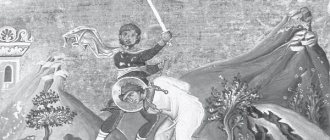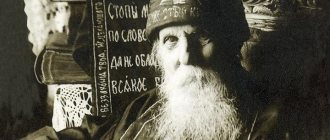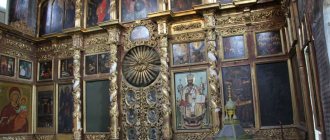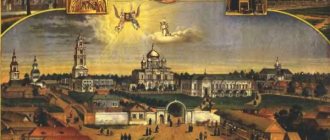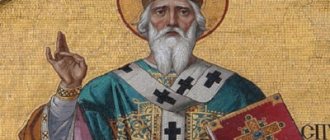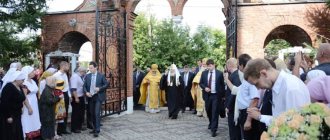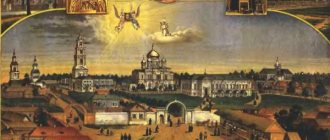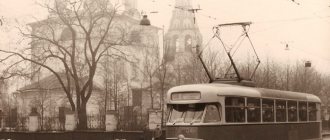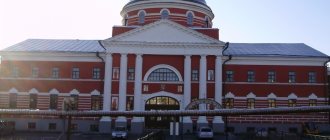Mir
Russia Leningrad region urban village Vyritsa Church of the Kazan Icon of the Mother of God (Vyritsa) Map is loading…
{"format":"leaflet","minzoom":false,"maxzoom":false,"limit":50,"offset":0,"link":"all","sort":[""], "order":[],"headers":"show","mainlabel":"","intro":"","outro":"","searchlabel":"\u2026 \u0441\u043b\u0435\ u0434\u0443\u044e\u0449\u0438\u0435 \u0440\u0435\u0437\u0443\u043b\u044c\u0442\u0430\u0442\u044b","default":"","import-annotation":false,"width ":"auto","height":"350px","centre":{"text":"","title":"""link":"""lat":59.40305000000000035242919693700969219207763671875,"lon": 30.300850000000000505906427861191332340240478515625,"icon":""},"title":"","label":"","icon":"","lines":[],"polygons":[],"circles":[ ],"rectangles":[],"copycoords":false,"static":false,"zoom":8,"defzoom":14,"layers":["OpenStreetMap"],"image layers":[] ,"overlays":[],"resizable":false,"fullscreen":true,"scrollwheelzoom":true,"cluster":false,"clustermaxzoom":9,"clusterzoomonclick":true,"clustermaxradius":80, "clusterspiderfy":true,"geojson":"","clicktarget":"","showtitle":true,"hidenamespace":false,"template":"","userparam":"","activeicon": "","pagelabel":false,"ajaxcoordproperty":"","ajaxquery":"","locations":[{"text":"\u003Cb\u003E\u003Ca href=\"/palomnik/%D0% A6%D0%B5%D1%80%D0%BA%D0%BE%D0%B2%D1%8C_%D0%9A%D0%B0%D0%B7%D0%B0%D0%BD%D1%81% D0%BA%D0%BE%D0%B9_%D0%B8%D0%BA%D0%BE%D0%BD%D1%8B_%D0%91%D0%BE%D0%B6%D0%B8%D0% B5%D0%B9_%D0%9C%D0%B0%D1%82%D0%B5%D1%80%D0%B8_(%D0%92%D1%8B%D1%80%D0%B8%D1%86 %D0%B0)\» title=\»\u0426\u0435\u0440\u043a\u043e\u0432\u044c \u041a\u0430\u0437\u0430\u043d\u0441\u043a\u043e\u0439 \u0438\u043a\ u043e\ u043d\u044b \u0411\u043e\u0436\u0438\u0435\u0439 \u041c\u0430\u0442\u0435\u0440\u0438 (\u0412\u044b\u0440\u0438\u0446\u0430)\ »\u003E\u0426\u0435\ u0440\u043a\u043e\u0432\u044c \u041a\u0430\u0437\u0430\u043d\u0441\u043a\u043e\u0439 \u0438\u043a\u043e\u043d\u044b \u0411\u 043e\u0436\u0438\u0435\u0439\ href= \"/palomnik /%D0%A1%D0%B2%D0%BE%D0%B9%D1%81%D1%82%D0%B2%D0%BE:%D0%90%D0%BD%D0%BD%D0%BE %D1%82%D0%B0%D1%86%D0%B8%D1%8F\" title=\"\u0421\u0432\u043e\u0439\u0441\u0442\u0432\u043e:\u0410\u043d\u043d\ u043e\u0442\u0430\u0446\u0438\u044f\»\u003E\u0410\u043d\u043d\u043e\u0442\u0430\u0446\u0438\u044f\u003C/a\u003E: \u043e\u044 1\u043d\u043e\u0432 \u0430\u043d\u0430 \u0432 1913 \u0433\u043e\u0434\u0443, \u0437\u0434\u0435\u0441\u044c \u043f\u043e\u043a\u043e\u044f\u044 2\u0441\u044f\u043c\u043e\u0449 "title":" u0435\u0440\ u043a\u043e\u0432\u044c \u041a\u0430\u0437\u0430\u043d\u0441\u043a\u043e\u0439 \u0438\u043a\u043e\u043d\u044b \u0411\u043e\u 0436\u0438\u0435\u0439\u041c\ u0430\u0442\u0435\u0440\u0438 (\u0412\u044b\u0440\u0438\u0446\u0430)","link":"","lat":59.4030500000000003524291969370096921920776367 1875,"lon":30.300850000000000505906427861191332340240478515625,"icon":"" }],"imageLayers":[]}
59.40303; 30.30083
Russia, Leningrad region, Gatchina district, urban village of Vyritsa, Kirova Avenue, 49
urban village of Vyritsa, Leningrad region 188380
Russia
Telephone:
+7 (81371) 49233, +7 (911) 0800148
Email:
Church of the Kazan Icon of the Mother of God
Founded in 1913, the relics of Seraphim Vyritsky rest here.
History[edit]
In 1910, on the lands of His Serene Highness Prince Peter Fedorovich Wittgenstein, the dacha settlement “Princely Valley” was created, the intensive settlement of which began immediately. Even when planning the territory, it was planned to allocate a site along Rakeevskaya Street between Pilny and Maysky Avenues for the construction of a temple. However, the issue was raised only on August 2 (15), 1912 at a general meeting of village residents. At the same time, the proposed site was considered inconvenient, so a new one was found at the corner of Rakeevskaya Street and Magistralny Avenue. The cost of land here was higher than on the first plot, but the prince agreed to make a 50% discount, and donated almost half of the remaining amount himself. The required 717 rubles were collected by residents by subscription. In order for the site to have an owner, the Brotherhood was founded in honor of the icon of the Kazan Mother of God, the charter of which was approved on December 9 (22), 1912 by Metropolitan Vladimir of St. Petersburg and Ladoga.
The Council of the Brotherhood decided to build the Church of the Kazan Icon of the Mother of God in memory of the 300th anniversary of the reign of the House of Romanov. Five works were submitted to the competition for the temple design. The project of architects V. P. Apyshkov and M. V. Krasovsky was chosen by a majority of votes. Issues of financing the construction of the temple were decided by the Brotherhood Council. Prince P. F. Wittgenstein, using 717 rubles, which the Brotherhood paid for the land, purchased a plot at 13 Melnichny Prospekt and allowed the use of its forest for the construction of a temple. In addition, using additional funds raised, Prince P. F. Wittgenstein sold another 1000 logs. The plot itself was sold again, and the owner donated the funds for the construction of the temple. To increase the significance of the enterprise in the eyes of high society, the Brotherhood turned on February 27 (March 12), 1913, to the prince of the imperial blood, John Konstantinovich, with a request to become its honorary chairman, to which consent was received on March 20 (April 2).
On July 14 (27), 1913, Bishop of Tobolsk and Siberia Alexy (Molchanov) laid the foundation stone for the temple. By winter the church was completely ready, the area was surrounded by a fence. The decoration of the temple began in the spring; on May 26 (June 8), 1914, bells and crosses were raised, consecrated by Archbishop Nikon (Rozhdestvensky). The construction and equipment of the temple cost 53,904 rubles. The temple was consecrated on July 26 (August 8), 1914 by Bishop Veniamin (Kazan) of Gdov. The honorary chairman of the Brotherhood, Prince John Konstantinovich himself, was unable to attend the consecration due to the outbreak of war.
Services in the temple were performed only in the summer. In 1921, a new iconostasis was installed in the church, transported from the closed shelter church of the Brusnitsin brothers. In 1928-1930 the parish joined the Josephite movement. After the closure of the Alexander Nevsky Lavra in 1933, its confessor, Hieroschemamonk Seraphim (Muravyov), moved to Vyritsa, who at first periodically served in the temple, being its parishioner. In 1938 the temple was closed. The OSOAVIAKHIM society was located in its premises, while the parishioners managed to preserve most of the icons, utensils and elements of the temple’s decoration.
After the occupation of Vyritsa by the Germans in 1941, the temple was reopened. In many ways, the consent of the German command to services in the church was due to the fact that there was a unit in the village, mainly consisting of Orthodox Romanians. The church did not close even after the liberation of Vyritsa. In 1959, the Commissioner for Religious Affairs for the Gatchina District issued an order to close the temple. This did not happen, thanks to the active position of the village residents, who sent a petition to the Presidium of the Supreme Council, and the order was canceled.
How to get there?
Many pilgrims are interested in how to get from St. Petersburg to the Kazan Church of the Icon of the Mother of God.
The easiest way to get to Vyritsa is by one of the suburban trains that depart from Vitebsky Station (located in close proximity to the Pushkinskaya metro station).
Electric trains in the direction of Vyritsa run quite often.
How to get from Pulkovo Airport (St. Petersburg)? From the airport terminal, you should first take a city bus to the Moskovskaya metro station, and then change to the metro to the Kupchino station. Electric trains depart regularly from the Kupchino platform to Vyritsa.
This is interesting! The exact address of the Church of St. Nicholas the Wonderworker
Vyritsa railway station is located 3 km from the temple. If you wish and there is good weather, you can get to the church on foot (how to get there, you can ask local residents or use a navigator).
You can also get to the church by taxi or city bus (stop “Ul. Rakeevskaya”). The bus stop is located in close proximity to the platform.
During a walk to the temple, you can visit two interesting places that are connected with the life of Seraphim Vyritsky:
- The house at 9 Pilny Prospect, where during the Great Patriotic War the saint prayed on a stone for 1000 days for the salvation of his Motherland.
- The house at 39 Maysky Avenue, which was the last earthly refuge of the saint.
Note! A walk to the church and a visit to memorable places is a kind of pilgrimage that cleanses not only the spirit, but also the body. You can walk this entire path with prayer in your heart.
The village of Vyritsa is famous not only for the fact that on its territory there is a chapel with the relics of St. Seraphim Vyritsky. A healer lives here who helps remove damage, get rid of a serious illness, resolve a difficult life situation, and remove the crown of celibacy.
It is best to come to the healer on weekdays, since she does not accept people on Sunday, and on Friday and Saturday she has long queues. More detailed information can be obtained from local residents.
Architecture and interior decoration[edit]
The temple was built in the style of tent-roofed wooden churches of the Russian North, in particular Olonets and Vologda. Modern technologies at that time were used during construction. The building is a traditional octagon-on-quadruple type for tented churches. The church itself is surrounded by a walkway and has a basement. The entrance to the temple is through a porch leading to the vestibule. The church is designed for 600-700 worshipers.
There are three chapels in the temple: the main one - in honor of the Kazan Icon of the Mother of God; southern - in the name of St. Nicholas the Wonderworker; northern (in the basement) - in the name of the Venerable Seraphim of Sarov and Alexy, the man of God.
The first oak carved two-tier iconostasis was built according to the drawings of M. V. Krasovsky. In 1922 it was moved to the Nikolsky chapel. The icons on the Royal Doors, as well as the images of the Savior and the Mother of God, are executed in the style of open Greek writing. The central wooden iconostasis made of bog oak was transported in 1922 from the Church of St. Nicholas the Wonderworker at the House of Care for Young Orphans in memory of Nikolai and Elena Brusnitsyn on the Oblique Line. The choirs and large icons in icon cases were moved from there. Also from the St. Nicholas Church are two paintings by N. A. Koshelev, painted by him in 1898: “The Mother of God - the Joy of All Who Sorrow” and “The Blessing of Children.”
A cypress altar on an oak base with marble trim was donated for the consecration of the temple by A. A. Kuznetsov and M. M. Ignatiev. During the consecration, P. I. Letunovsky donated a two-tier bronze chandelier for 28 candles with crystal chains. After the consecration, in the temple there was an icon of the Resurrection of Christ with a particle of the stone of the Holy Sepulcher, sent by the Patriarch of Jerusalem Damian.
At the right choir of the central chapel, in the icon case, there is the Kazan Icon of the Mother of God - the ancestral image of the Muravyov family, from which the Monk Seraphim Vyritsky came.
Relics and chapel
Next to the Kazan Church of the Icon of the Mother of God there is a wooden chapel where the relics of Seraphim Vyritsky are kept.
It was erected in 2001. The architect S.A. worked on its creation. Pavlov. The chapel was built in the cage style with its characteristic rectangular façade and gable roof.
Next to the saint’s grave is the grave of his wife, schema-nun Seraphima (Muravyeva).
Interesting! Strong prayer for the health of our parents
Anyone can come to venerate the relics of the saint at any time. During his life, the great elder told people: “Come to my grave as if you were alive, talk as if you were alive, and I will always help you.”
And for several decades now, a continuous line of people has been coming to the saint’s grave with their prayers, requests and gratitude. Believers are confident that in this holy place the Lord will definitely hear them and answer their prayer.
People revere the monk as a miracle worker. He is contacted when required:
- healing from illness;
- peace of mind and tranquility;
- searching for the true path;
- searching for a soul mate, strengthening relationships between spouses, the birth of a long-awaited child;
- assistance with work and financial well-being;
- solving various life and everyday problems;
- relief of grief.
Note! If it is not possible to come and venerate the relics of the saint, you can buy an icon of St. Seraphim of Vyritsky and read a prayer in front of it every day.
Patronal holidays[edit]
Icon of the Blessed Virgin Mary “Kazan”
— July 21, November 4
Alexy, man of God, reverend
- 30th of March
Nicholas the Wonderworker, Archbishop of Myra, Saint
— May 22, December 19
Seraphim of Sarov, Rev.
— January 15, August 1
Church in Kupchino
Today, in the Kupchino district (St. Petersburg), a magnificent temple of Seraphim Vyritsky is being built with donations from believers.
He is active. You can visit it daily from 09:00 to 19:00. You can get to the temple from the Kupchino metro station by trams No. 45 and 62.
There is a Sunday school for adults and children on the church premises. Here they read the Old Testament, introduce believers to the acts of the apostles, and even draw and make various crafts.
Every second Sunday of the month, everyone is invited to a prayer service in front of the icon of Peter and Fevronia. In front of the icon, you can pray for the birth of a child, ask for help in finding a soul mate, creating an Orthodox family and strengthening marital ties.
The Seraphim Pilgrimage Center operates at the temple, located at Zagreb Boulevard, 26. Pilgrimage trips to holy places in Russia and around the world are regularly organized here.
Note! The Church of Seraphim Vyritsky in Kupchino needs financial resources, since the construction process is not yet completed. If you wish, you can do a charitable deed and donate any amount of money for the improvement of the temple.
